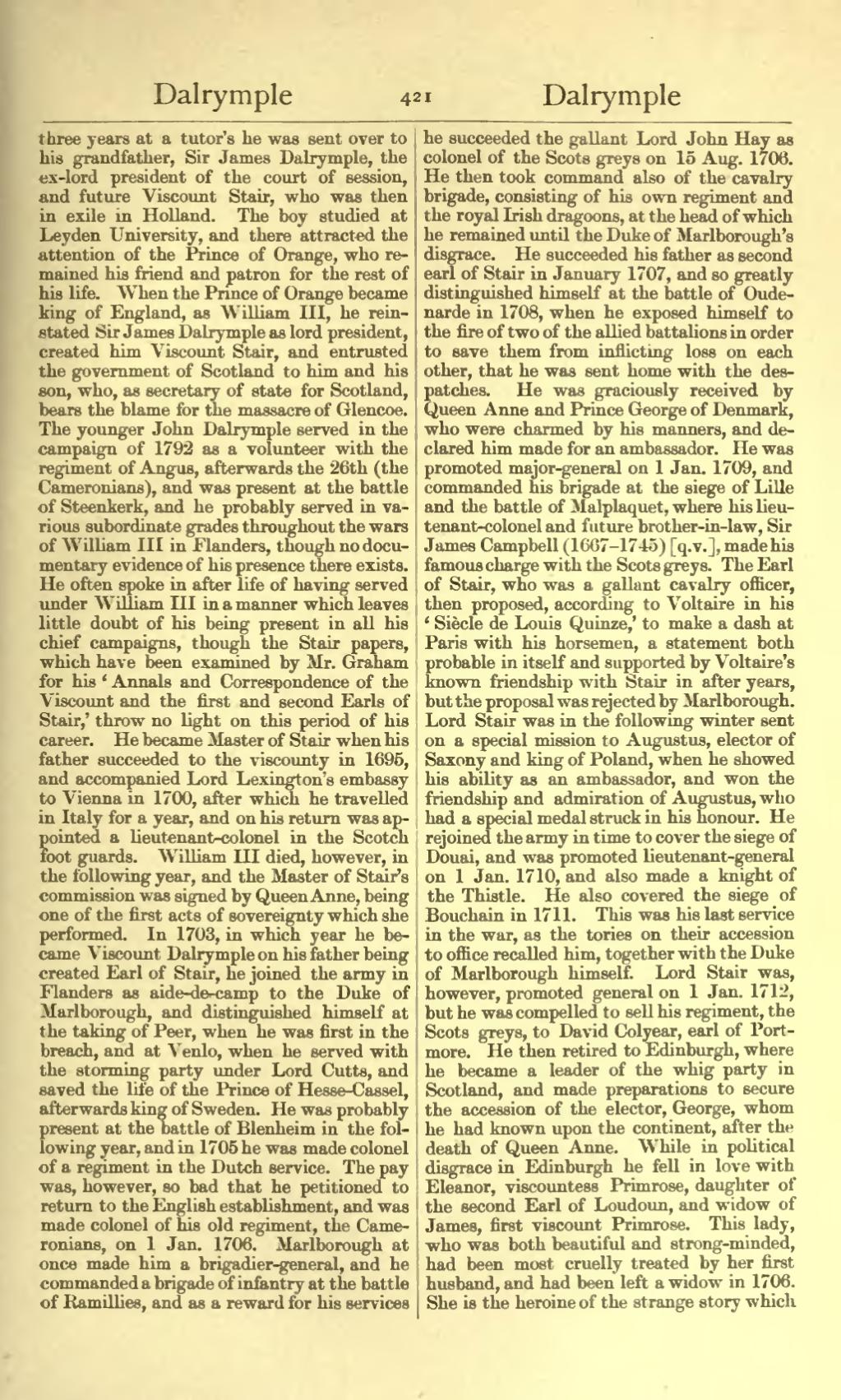three years at a tutor's he was sent over to his grandfather, Sir James Dalrymple, the ex-lord president of the court of session, and future Viscount Stair, who was then in exile in Holland. The boy studied at Leyden University, and there attracted the attention of the Prince of Orange, who remained his friend and patron for the rest of his life. When the Prince of Orange became king of England, as William III, he reinstated Sir James Dalrymple as lord president, created him Viscount Stair, and entrusted the government of Scotland to him and his son, who, as secretary of state for Scotland, bears the blame for the massacre of Glencoe. The younger John Dalrymple served in the campaign of 1692 as a volunteer with the regiment of Angus, afterwards the 26th (the Cameronians), and was present at the battle of Steenkerk, and he probably served in various subordinate grades throughout the wars of William III in Flanders, though no documentary evidence of his presence there exists. He often spoke in after life of having served under William III in a manner which leaves little doubt of his being present in all his chief campaigns, though the Stair papers, which have been examined by Mr. Graham for his ‘Annals and Correspondence of the Viscount and the first and second Earls of Stair,’ throw no light on this period of his career. He became Master of Stair when his father succeeded to the viscounty in 1695, and accompanied Lord Lexington's embassy to Vienna in 1700, after which he travelled in Italy for a year, and on his return was appointed a lieutenant-colonel in the Scotch foot guards. William III died, however, in the following year, and the Master of Stair's commission was signed by Queen Anne, being one of the first acts of sovereignty which she performed. In 1703, in which year he became Viscount Dalrymple on his father being created Earl of Stair, he joined the army in Flanders as aide-de-camp to the Duke of Marlborough, and distinguished himself at the taking of Peer, when he was first in the breach, and at Venlo, when he served with the storming party under Lord Cutts, and saved the life of the Prince of Hesse-Cassel, afterwards king of Sweden. He was probably present at the battle of Blenheim in the following year, and in 1705 he was made colonel of a regiment in the Dutch service. The pay was, however, so bad that he petitioned to return to the English establishment, and was made colonel of his old regiment, the Cameronians, on 1 Jan. 1706. Marlborough at once made him a brigadier-general, and he commanded a brigade of infantry at the battle of Ramillies, and as a reward for his services he succeeded the gallant Lord John Hay as colonel of the Scots greys on 15 Aug. 1706. He then took command also of the cavalry brigade, consisting of his own regiment and the royal Irish dragoons, at the head of which he remained until the Duke of Marlborough's disgrace. He succeeded his father as second earl of Stair in January 1707, and so greatly distinguished himself at the battle of Oudenarde in 1708, when he exposed himself to the fire of two of the allied battalions in order to save them from inflicting loss on each other, that he was sent home with the despatches. He was graciously received by Queen Anne and Prince George of Denmark, who were charmed by his manners, and declared him made for an ambassador. He was promoted major-general on 1 Jan. 1709, and commanded his brigade at the siege of Lille and the battle of Malplaquet, where his lieutenant-colonel and future brother-in-law, Sir James Campbell (1667–1745) [q. v.], made his famous charge with the Scots greys. The Earl of Stair, who was a gallant cavalry officer, then proposed, according to Voltaire in his ‘Siècle de Louis Quinze,’ to make a dash at Paris with his horsemen, a statement both probable in itself and supported by Voltaire's known friendship with Stair in after years, but the proposal was rejected by Marlborough. Lord Stair was in the following winter sent on a special mission to Augustus, elector of Saxony and king of Poland, when he showed his ability as an ambassador, and won the friendship and admiration of Augustus, who had a special medal struck in his honour. He rejoined the army in time to cover the siege of Douai, and was promoted lieutenant-general on 1 Jan. 1710, and also made a knight of the Thistle. He also covered the siege of Bouchain in 1711. This was his last service in the war, as the tories on their accession to office recalled him, together with the Duke of Marlborough himself. Lord Stair was, however, promoted general on 1 Jan. 1712, but he was compelled to sell his regiment, the Scots greys, to David Colyear, earl of Portmore, in 1714. He retired to Edinburgh, where he became a leader of the whig party in Scotland, and made preparations to secure the accession of the elector, George, whom he had known upon the continent, after the death of Queen Anne. While in political disgrace in Edinburgh he fell in love with Eleanor, viscountess Primrose, daughter of the second Earl of Loudoun, and widow of James, first viscount Primrose. This lady, who was both beautiful and strong-minded, had been most cruelly treated by her first husband, and had been left a widow in 1706. She is the heroine of the strange story which
